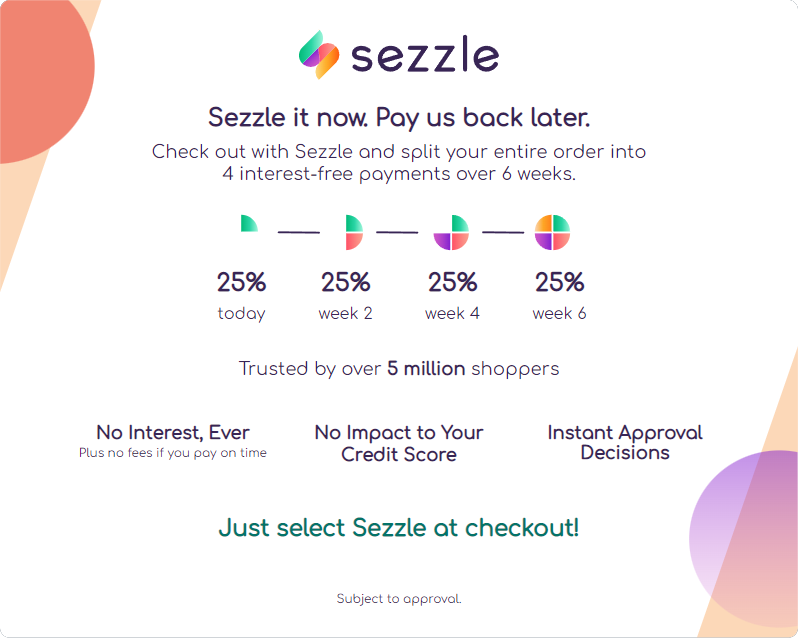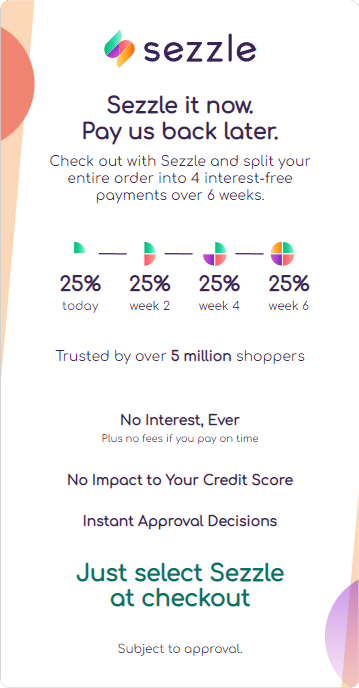



We provide a 24-month warranty on all of our products.

We take immense pride in our products and know you're going to love them as much as we do. If you're not 10/10 obsessed, let us know within 30 days for our 100% money back guarantee.

 ✕
✕
Check out with Sezzle and split your entire order into 4 interest-free payments over 6 weeks.
On all orders $90USD+ we offer free 2-7 business day standard shipping in the US + CA and 11-20 business day shipping in the UK.
Unfortunately we are unable to make deliveries to PO boxes, APO/FPO, or US military bases outside the US.

 Taylor LED Compact Mirror
Taylor LED Compact Mirror
 Vera Vanity with 10x Lara Mirror
Vera Vanity with 10x Lara Mirror
 Rivo Nano Ionic Facial Steamer
Rivo Nano Ionic Facial Steamer
 Abigail LED Travel Mirror
Abigail LED Travel Mirror
 Mini Taylor LED Compact Mirror
Mini Taylor LED Compact Mirror
 Ultimate Mirror Bundle
Ultimate Mirror Bundle
 Abigail 10x Travel Mirror
Abigail 10x Travel Mirror
 Mila 2 Luxe LED Compact Mirror
Mila 2 Luxe LED Compact Mirror
 Tru-Glow Lighted Mirrors Duo
Tru-Glow Lighted Mirrors Duo
 Clara Microdermabrasion Device
Clara Microdermabrasion Device
 Mix and Match Set
Mix and Match Set
 Cali Electric Callus Remover
Cali Electric Callus Remover
 Isla Facial Cleansing Brush
Isla Facial Cleansing Brush
 Madison Makeup Case
Madison Makeup Case
 The Glow Getter Ritual Set
The Glow Getter Ritual Set
 Mila 2 LED Compact Mirror
Mila 2 LED Compact Mirror
 Madeline Mini Hollywood Mirror
Madeline Mini Hollywood Mirror
 Mini Taylor LED Compact Mirror | Romantic Florals
Mini Taylor LED Compact Mirror | Romantic Florals
 Vera Lighted Vanity Mirror
Vera Lighted Vanity Mirror
 Lana 10x Magnifying Mirror
Lana 10x Magnifying Mirror
 Juni 2 Lighted Car Visor Mirror
Juni 2 Lighted Car Visor Mirror
 Taylor LED Compact Mirror | Cheetah Chic
Taylor LED Compact Mirror | Cheetah Chic
 Mini Taylor LED Compact Mirror | Cosmic Leopard
Mini Taylor LED Compact Mirror | Cosmic Leopard
 Cami Lighted Handheld Mirror
Cami Lighted Handheld Mirror
 Pore-Parazzi Set
Pore-Parazzi Set
 2 Be Lit Mirror Duo
2 Be Lit Mirror Duo
 Aria Pro Makeup Brush Set
Aria Pro Makeup Brush Set
 Love at First Light Mirror Set
Love at First Light Mirror Set
 Daily Essentials Skincare Kit
Daily Essentials Skincare Kit
 Taylor LED Compact Mirror | Blush Zebra
Taylor LED Compact Mirror | Blush Zebra
 Glowing Places Kit
Glowing Places Kit
 Mini Taylor LED Compact Mirror | Cheetah Chic
Mini Taylor LED Compact Mirror | Cheetah Chic
 Mini Taylor LED Compact Mirror | Blush Zebra
Mini Taylor LED Compact Mirror | Blush Zebra
 Mira 2 Magnifying Mirror 10x
Mira 2 Magnifying Mirror 10x
 Farah Makeup Remover Set
Farah Makeup Remover Set
 Remi Uplift Facial Massage Roller
Remi Uplift Facial Massage Roller
 Macy Makeup Bag
Macy Makeup Bag
 Avery Spa Headband Set
Avery Spa Headband Set
 Harper Makeup Sponge Set
Harper Makeup Sponge Set
 Tara 10x Magnifying Mirror
Tara 10x Magnifying Mirror
 Leather Pouch for Compact Mirror
Leather Pouch for Compact Mirror
 Zoe Eye Cleansing Pad
Zoe Eye Cleansing Pad
 Tasha Heated Eyelash Curler
Tasha Heated Eyelash Curler
 Charlotte Scalp Massager
Charlotte Scalp Massager
 Lara 10x Magnifying Mirror for Vera
Lara 10x Magnifying Mirror for Vera
 Zoe Drying Pads
Zoe Drying Pads
 Traveling Twosome
Traveling Twosome
 Tala Gooseneck Attachment for Mira
Tala Gooseneck Attachment for Mira
![Gift Card [USD]](http://fancii.com/cdn/shop/products/fancii-gift-card_45x.gif?v=1762198925) Gift Card [USD]
Gift Card [USD]
![Gift Card [CAD]](http://fancii.com/cdn/shop/products/fancii-gift-card_8caf3995-16f8-44ab-90b2-3aa4b3050424_45x.gif?v=1762269131) Gift Card [CAD]
Gift Card [CAD]
![Gift Card [GBP]](http://fancii.com/cdn/shop/products/fancii-gift-card_bda6bc27-1ef2-4efb-bf94-e3f8882f7d97_45x.gif?v=1762269131) Gift Card [GBP]
Gift Card [GBP]
 Elle Satin Scrunchie
Elle Satin Scrunchie
 Mini Taylor LED Compact Mirror | Mediterranean Coast
Mini Taylor LED Compact Mirror | Mediterranean Coast
 Glowcation Station
Glowcation Station
 Taylor LED Compact Mirror | Cosmic Leopard
Taylor LED Compact Mirror | Cosmic Leopard

Whether you have trouble with your vision or not, when you work or play in the world of the very small, you need all the help you can get. Lighted magnifiers offer a distinct advantage over those without their own light source because they can help to further reduce unnecessary eyestrain and fatigue. Think about it. The darker your immediate area is, the more difficult it will be to read the newspaper, study a coin collection, or see the fine print on your medication, regardless of how powerful a magnifier you use.
Making use of task lighting in a well-lit room can help tremendously, but magnifiers that provide their own bright and directional illumination can help even more. The fact is, the better the quality of light you use, the less magnification you’ll need to comfortably see what you’re doing.
The field of view provided by a magnifier is the area beneath the lens that’s actually in focus. The size of this area becomes smaller as the power, or magnification, of a lens becomes higher. While you can see more detail with a more powerful magnifier, that benefit comes at a price, since you can only focus on a relatively small part of an object at any one time.
By adding a light source to your magnifier, you can decrease the power that’s required and increase your viewable area. Less powerful lenses tend to be less expensive, and are often larger and easier to handle.
Using a lighted magnifier also means you can take advantage of a longer focal length, or working distance, between your lens and that very small world you’re trying to view. Defined as the distance from the center of your magnifying lens to the optimal point of focus, the focal length of a magnifier is what determines just how much room you and your tools will have to move around; whether your task involves working on needlepoint, or repairing a watch.
Since this focal length increases as magnification decreases, the better the light, the lower the lens magnification required, and the larger your working area becomes. Overall, a lighted magnifier can provide you with a far more relaxed and comfortable viewing experience than a non-lighted one.
So how do you know which is the best lighted magnifier for you?
The first point to recognize is that not all light is created equal. For example, an LED bulb uses far less energy than a halogen bulb, and can last up to ten times as long as a fluorescent one. LED light is also extremely directional compared to other types of lighting, meaning that most of it lands directly on whatever it is you’re trying to see, rather than on everything else in the room. The LED bulb is far more durable than its halogen counterpart, and it has the added benefit of remaining cool to the touch, no matter how long you leave it on.
If you’ve decided that an LED lighted magnifier is the way to go, the great news is that they’re available in a range of magnifications and styles – from handheld, to hands-free, to the loupe variety. The power and type you choose will depend on the size of magnifying tool you prefer to use and, more importantly, on the task at hand.
If you want to read a label, study a map, or enjoy the latest best-seller, a lighted handheld magnifier or reading glass might work best for you. If, on the other hand, you need to use your hands or other tools to manipulate whatever it is you’re looking at, then a hands-free version is probably your best choice.
Generally speaking, the typical LED illuminated handheld or hands-free magnifier offers a larger field of view than the average lighted loupe, but loupes too come in both handheld and hands-free designs for those looking to get a better view of the fine detailing on a coin, stamp, or gem.
From mini loupes for your pocket or keychain, to fully adjustable workstation magnifiers ideal for electronics and crafts, there’s a brightly lit magnifier that’s perfect for lighting the way through your next hobby, book, or fine craft project.